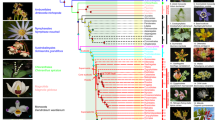Summary
By inferences from fossil records and circumstantial evidences, it is now generally postulated that angiosperms have a much longer history than hitherto believed and that they have already existed probably in Jurassic time. Studies in vascular tissues and reproductive, structures have negated the possibility of originating angiosperms from various gymnosperm groups. Chronologically, this derivation will be also an impossibility.
From a consideration of various aspects in the life history of angiosperms, a hypothesis is here presented postulating that protangiosperms originated in an aquatic or subaquatic environment from an algal ancestry. The enclosure of ovules in the ovary is interpretated as a means of protection necessitated for the transmigration from an aquatic to an aerial habitat for the developing reproductive parts in the bud underwater. Trimery is suggested as a primitive condition, one that affords maximum efficiency in carrying out the purpose under the conditions.
In the life history of angiosperms, the endosperm is of great significance in phylogeny. From morphological, physiological, cytological as well as genetical considerations, the endosperm should be regarded as of equal status with the gametophytic and sporophytic generations. There is no comparable structure in the gymnosperm groups and the ferns and “fern-allies”, while more or less similar conditions are present in the thallophytes. In the long life histories of many red algae, however, there is an especially notable resemblance to angiosperms, with certain details approaching the unique and characteristic features of the endosperms.
Land plants are presumably all evolved from aquatic ancestors but instead of the usual concept of a monophyletic origin and lineal development of all vascular plants, a more plausible suggestion is the multiple and recurrent derivation of such plants from various algal ancestral groups. The angiosperms probably represent one of such major lines that originated more or less directly from a thallophytic ancestry.
Similar content being viewed by others
Bibliography
Andreansky, F. (1952). Über die Rolle der limnischen Lebensweise in der Phylogenie der Pflanzen. - Acta Biol. III, p. 19–30.
Axelrod, D. I. (1952). A theory of angiosperm evolution. - Evolution IV, p. 29–60.
Bailey, I. E. (1949). Origin of angiosperms: need for a broadened outlook. - J. Arnold Arbor. XXX, p. 64–70.
Bertrand, P. (1937). Isolement precose de tous les grands groupes de végétaux vasculaires. - Bull. Soc. bot. Fr. LXXXIV, p. 713–720.
Bews, J. W. (1927). Studies in the ecological evolution of the angiosperms. - New Phytol. XVI, p. 1–134.
Campbell, D. H. (1940). The evolution of land plants. - Stanford Calif., Stanford Univ. Press, x + 731 p.
Church, A. H. (1919). Thalossiophyta and the subaerial transmigration. - Oxf. bot. Mem. IIIb, p. 1–95.
Constance, L. (1955). The systematics of the angiosperms. - In: A century of progress in the natural sciences, p. 405–483.
Fritsch, F. E. (1945). The structure and reproduction of the Algae. II. - Cambridge, Cambridge Univ. Press, xii + 939 p.
Greguss, P. (1955). Xylotomischer Bestimmung der heute lebenden Gymnospermen. - Budapest, Akademiai Kiado, 308 p. (Reviewed by H. J. Lam in Blumea VII, p. 528–531, I957).
Just, T. (1948). Gymnosperms and the origin of the angiosperms. - Bot. Gaz. CX, p. 91–103.
Henslow, G. (1911). The origin of monocotyledons from dicotyledons, through selfadaptation to a moist or aquatic habit.- Ann. Bot., Lond. XXV, p. 714–744.
Leppik, E. E. (1955). Some viewpoints on the origin and evolution of flowering plants. - Acta biotheor., Leiden XI, p. 45–57.
Li, H. L. (1957). The evolutionary significance of endosperm and its bearing on the origin of angiosperms. - J. Wash. Acad. Sci. XLVII, p. 33–38.
Oltmanns, F. (1905). Morphologie und Biologie der Algae. II. - Jena., vi + 443 p.
Rothmaler, W. (1952). Die Gymnospermen und der Ursprung der Angiospermen. - Wiss. Z. Martin-Luther-Univ. Halle-Wittenberg, math.-nat. Reihe, Nr 3, I, H. 4, p. 1–12.
Schellenberg, G. (1928). Beiträge zu einem phylogenetischen System der Bluten- pflanzen. - Beibl. Vjschr. naturf. Ges. Zürich LXXIII, p. 355–381.
Seward, A. C. (1922). A study in contrast: the present and past distribution of certain ferns. - J. Linn. Soc. (Bot.) XLVI, p. 219–240.
Sinnott, E. W. &I. W. Bailey (1914). Investigations on the phylogeny of the angiosperms: 4. The origin and dispersal of herbaceous angiosperms. - Ann. Bot., Lond. XXVIII, p. 547–600.
Süssenguth, K. &H. Merxmüller (1952). Über die Herkunft der Angiospermen.- Phyton IV, p. 1–18.
Author information
Authors and Affiliations
Rights and permissions
About this article
Cite this article
Li, H.L. A theory on the ancestry of angiosperms. Acta Biotheor 13, 185–202 (1960). https://doi.org/10.1007/BF01602004
Received:
Issue Date:
DOI: https://doi.org/10.1007/BF01602004




